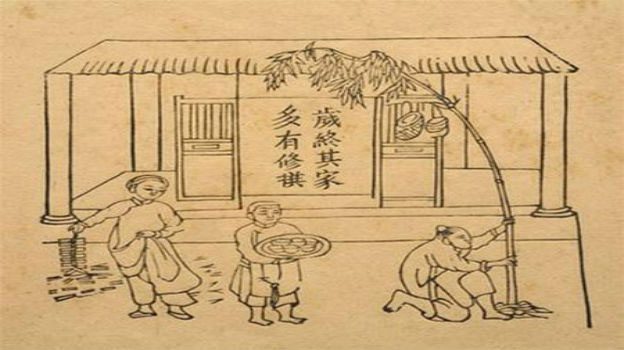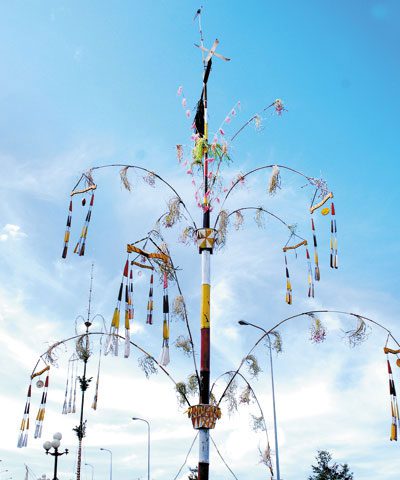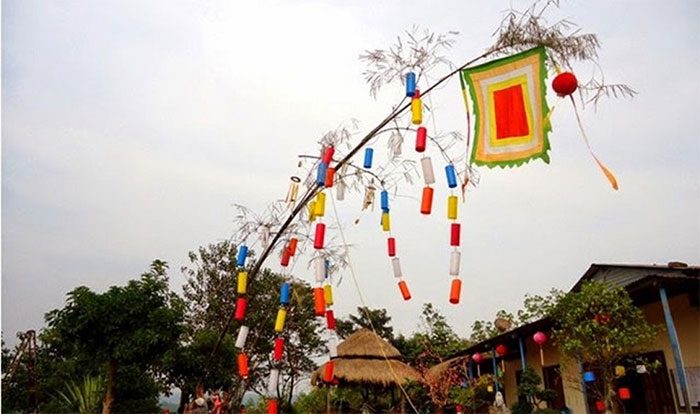What is the Nêu Tree? Many Vietnamese people may not be able to answer this question!
Origins and Significance of the Nêu Tree During Tet
The Nêu Tree during Tet has been a beautiful tradition of the Vietnamese for generations. Each Lunar New Year, families plant a Nêu Tree in front of their homes or erect it indoors, adorned with various symbolic items according to local customs.
However, if you pay attention, you will see that the “Nêu” varies from house to house, starting from the type of tree used. Many people use bamboo, while others may choose different types of grass-like plants such as reed, or even simply a sugarcane stalk.
So, what exactly is the Nêu?
The Legend of the Nêu Tree During Tet
Long ago, demons occupied all the land, while humans were merely laborers, giving most of their harvest to the demons. The demons exploited humans excessively, ultimately claiming the right to “eat the top and leave the roots.”
Humans were left with only the leftovers, making it impossible to survive, so they prayed to the Buddha for help. The Buddha advised them to stop planting rice and instead cultivate sweet potatoes. That harvest allowed humans to enjoy the sweet potatoes completely, while the demons only got the leaves and vines, adhering to their method of “eating the top and leaving the roots.”
In the following season, the demons switched to the method of “eating the roots and leaving the top.” The Buddha then told the humans to return to planting rice. As a result, the demons only obtained the leftovers, and their plans failed again.
Enraged, the demons declared that the next season they would “eat both the roots and the tops.” The Buddha provided humans with corn seeds to sow everywhere. The demons got nothing, while humans reaped a bountiful corn harvest. In the end, the demons were determined to force humans to return all their land and stop farming.
The Buddha advised humans to negotiate with the demons, asking for a piece of land the size of a shadow cast by a monk’s robe hung from the top of a bamboo tree. The demons, seeing no harm, agreed. At that moment, the Buddha used magic to make the shadow of the monk’s robe cover all the land, causing the demons to lose their territory and retreat to the East Sea.
Having lost their land, the demons rallied their forces to reclaim it. The Buddha instructed humans to attack using dog blood, screw pine leaves, garlic, and lime powder… The demons lost and were banished to the East Sea. Before leaving, the demons asked the Buddha for mercy, allowing them a few days each year to visit the land and pay respects to their ancestors. The Buddha, feeling pity, agreed.
Thus, annually, during Tet, on the days when the demons visit the land, people follow the old custom of planting a Nêu Tree to prevent the demons from approaching their homes. On the Nêu Tree, they hang a land bell that makes a sound in the wind to remind the demons to stay away. At the top of the Nêu, they also tie a bundle of screw pine leaves or a banyan branch to frighten the demons. Additionally, they draw arrow shapes pointing east and sprinkle lime powder at the entrance during Tet to ward off the demons.
The Nêu Tree in Vietnamese Literary History
The Nêu Tree originates from “the legend of the Nêu Tree during Tet.” To understand what a Nêu Tree is, let’s explore a simplified version of this story, as told by Nguyễn Đổng Chi in the Collection of Vietnamese Folktales.
From the above legend, we can see that the “original version” of the Nêu Tree is the bamboo tree. This legend aligns with Buddhist and Taoist teachings, which state that during Tet, a Nêu Tree must be erected in front of the house to drive away evil spirits. The Nêu Tree becomes a symbol of protection for human peace during the sacred days while people celebrate and entertain themselves.

The Nêu Tree in folklore is indeed the bamboo tree.
However, over time, the Nêu Tree has become more of a symbolic object than an actual type of tree. Nowadays, the Nêu Tree generally refers to a tree trunk and differs in each region and ethnic group.
For major festivals of the Kinh people, the Nêu Tree may be made from reed, bamboo, or tall cleaned bamboo. Meanwhile, ethnic minorities may use certain types of sturdy wood, such as the gạo tree of the Gia Rai people.

The Nêu Tree of the Central Highlands people.
The items hung on the Nêu Tree also vary by region. According to the legend of the Kinh people, the Nêu Tree is adorned with a land bell, a bundle of screw pine leaves, or a banyan branch to ward off evil spirits.
However, other ethnic groups might hang different items, such as carp for the Kitchen Gods, protective charms, or simply drawings based on their unique customs.
How to Erect and Remove the Nêu Tree During Tet
The custom of erecting the Nêu Tree during Tet may differ by region. Below is the most common and general method.
Timing and Method for Erecting the Nêu Tree
The Nêu Tree is erected on the 23rd day of the last lunar month, which is the day the Kitchen Gods return to Heaven. The Nêu Tree is typically set up on this day because from then until New Year’s Eve, the absence of the Kitchen Gods gives the demons an opportunity to sneak in and cause disturbances, so the Nêu Tree is planted to ward off evil.
Some other ethnic groups, such as the Mường people, plant the Nêu Tree on the 28th of the lunar month, while the Hmong people erect the Nêu Tree during a blessing festival held from the 3rd to the 5th day of the Lunar New Year.

The Nêu Tree will be erected on the 23rd day of the last lunar month, which is the day the Kitchen Gods return to Heaven.
The method for erecting the Nêu Tree is as follows:
The Nêu Tree is erected in front of the house.
- The Nêu Tree must be made from bamboo about 5–6 meters long, as bamboo has segments, which serve as a pathway for deities, bringing the spirit of heaven down to the earth, ensuring fertility and good harvests.
- The bamboo must be mature, thick, and straight, without a broken top. The trunk can be decorated with various flags, banners, lanterns, couplets, clay pots containing lime, wind chimes, etc.
- At the base, sprinkle white lime powder to form a circle or sprinkle it in the shape of a bow and arrow pointing towards the gate to ward off evil spirits.
- At the top of the Nêu, hang numerous items (depending on local customs) such as small bags containing betel and areca nuts, flutes, joss paper, clay fish, and a round canopy made of bamboo and adorned with red paper, screw pine leaves, chicken feathers, banyan branches, etc.
- Depending on the region and specific customs, the Nêu Tree may have different hanging items such as small bags for betel and areca nuts, large and small metal pieces…
When the wind blows, these items clang together, creating a pleasant sound. People believe that these items, combined with the noise, signal to the demons that this home is inhabited and should not be disturbed.
Some places even hang a lantern on the Nêu Tree at night so that ancestors can find their way home to celebrate Tet with their descendants. On New Year’s Eve, the Vietnamese used to light firecrackers at the Nêu Tree to welcome the new year and drive away demons or bad omens.
Timing and Method for Removing the Nêu Tree
By the end of the 7th day of the first lunar month, the Nêu Tree will be taken down. The Vietnamese call the day of removing the Nêu Tree The Day of Opening the Nêu.
Before removing the Nêu Tree, the homeowner sets up a small table, placing a plate of watermelon, some incense, flowers, etc., at the base of the Nêu Tree to inform the heavens and earth that the family has had a joyful Tet celebration. After that, they will shake the Nêu Tree to drop all the dry leaves, take the Nêu Tree down, and hang the Nêu charm at the main entrance (the front door of the house).


















































